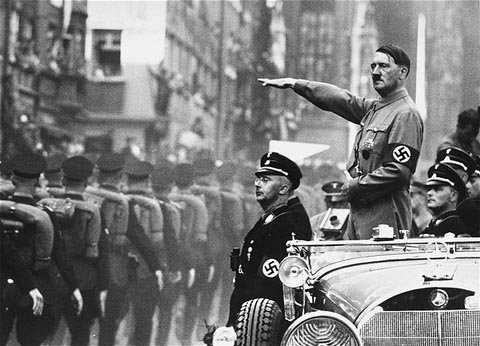Two Portrayals of Hitler
by Steven Molina (about the author), Dec. 2003
By analyzing two different books written at two different periods in time we can compare and contrast the different perspectives during Hitler's ascent into power. In Der Fuehrer Hitler's Rise to Power, written in 1944 by Konrad Heiden, the author gives his personal perspective of the events that occurred during the Nazi era. In comparison the book Hitler and Nazism by Enzo Collotti (our course textbook) is a contemporary retrospective, written in 1998. While Heiden gives narratives and observations during the Hitler regime, Collotti takes a completely different approach.
Collotti argues that the Versailles Treaty and existing economic factors helped Hitler ascend into power. Collotti's argument is illustrated when he states "The Versailles Treaty, signed on 28 June 1919 at the end of the First World War, imposed heavy conditions on Germany, which was considered responsible for the loss and devastations suffered by the Allied Governments" (11). Collotti not only establishes the economic crisis in Germany, but also ties in the existing political factors imposed by the crisis in the Weimar Republic. Collotti is able to demonstrate Germany's need for social, economical, and political reform. This is evident when Collotti refers to the "collapse of the balance between the social and political forces on which the political system of the 1919 constitution?" (11). Collotti displays the type of situation German finds itself before Hitler ascends into power. Since he showed hope and prosperity to German people, he proved to be a valuable leader and asset to the German people. It is for this reason that Hitler is able to take over the people of Germany with ease.
In comparison, Heiden's book gives more of a militaristic reason for Hitler's rise to power. Heiden is able to provide the reader with an illustrated account of Hitler's involvement with the German Workers party in 1919, and Hitler's role as leader of the National Socialist Party in 1921. Although Collotti's book does mention these events, they are not as descriptive as Heiden's account. Heiden is able to provide a vivid account of Hitler's life and his rise to power, and therefore is able to give the reader a more emotional sense of the events. This is illustrated when General Ludendorff said, "Events have taught me, and it pains me to own, that the leading stratum of our society is incapable of giving the German people the will of freedom" (32-33).
Both of these books mention the event in 1923 when Hitler tried to take control of the government by marching on Munich. They both give detailed accounts of the death of several Nazis who were killed in the attempt to take over. In Collotti's book, he briefly mentions Hitler's sentence of treason. Heiden, on the other hand, gives more of the reasons why Hitler feels the need to come to power. He states, "Hitler was in a desperate position, requiring of them a political decision they had no intention of making, since they no longer thought it necessary" (169). Heiden also goes on to mention Hitler's achievement with the authorship of Mein Kampf, a book that would later be considered the bible of the Nazis. In Hitler and Nazism, Collotti mostly mentions the events during the 1920s to 1930s. He emphasizes Hitler's ability to regroup and strengthen the Socialist National party under his leadership in 1926.
 |
Both of these books mention the famous 1930s Reichstag elections that would help Hitler gain the support of the people. In Collotti's book he is able to give more of an accurate account of Hitler's popularity. He mentions Hitler's popularity rising from 2 percent to 10% to 40%, etc. He also gives a vivid illustration of how President Hindenburg used Hitler's popularity to gain the support of his followers. It was not until Hindenburg appointed Hitler as Chancellor that he comes to governmental power in 1933. Halden, however, also gives an accurate portrayal of how Hindenburg appoints Hitler to chancellor. He describes the aftermath of Hindenburg's death, when Hitler was able to unite the position of chancellor and president into one. Halden even dedicates a chapter in his book called First Triumph where he talks about Hitler's title of Fuhrer.
Both of these books are able to express the same information, although they differ on the depth of description they give to various events. For example, Collotti mentions the Enabling Act within the Reich. This statute stated that the government did not have to adhere to the constitution nor oppose it. Even though these two books are written in two different time periods, they both are able to discuss the events that eventually lead to the burning of the Reichstag, which would further Hitler's aims in his struggle for power.
A great difference in these two books is the depth of information which each respective author provides. For example, Der Fuehrer Hitler's Rise to Power, is seven hundred and seventy pages long, while Hitler and Nazism is only one hundred and fifty one pages with pictures. Both of these books are able to provide the key facts, but if the reader wants to get an in depth realization for things he would have to read Der Fuehrer Hitler's Rise to Power. Heiden's book also gives a detailed account for Hitler's childhood, but if time is short and all you need is the straight hard facts, then Collotti's book would be more useful.